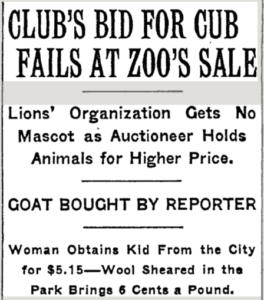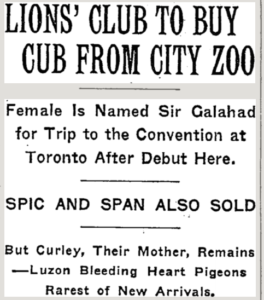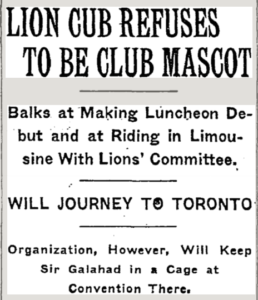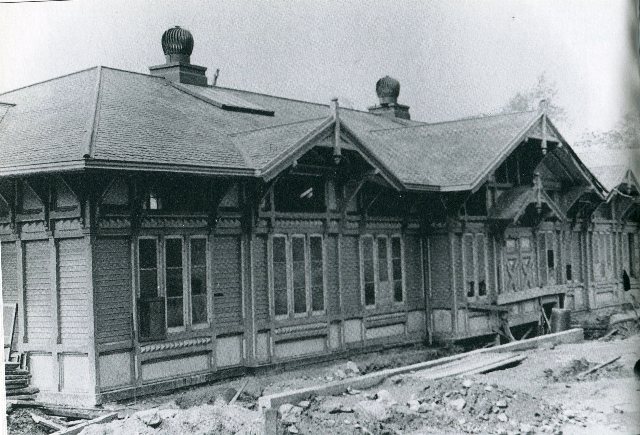
From my files called “You Can’t Make This Stuff Up,” the following is a remarkable story about the Lions Club of New York and a female lion cub inappropriately named Sir Galahad who refused to join the Lions. Only in Old New York…

The story begins on June 25, 1931. That is the day Vernon H. Galloway, secretary and mascot keeper of the Lions Club of New York, offered a $25 bid on one of four Central Park Zoo lions up for auction. The auctioneer rejected his bid.
Apparently, every year the park sold its surplus animals to the public; this year, three cubs (including twins named Spic and Span) and a six-year-old lioness named Curley were for sale. Henry Brady, the auctioneer who had sold the zoo’s extra animals every year for a decade, said no bids under $100 would be considered.
Since no one else in the crowd of about 300 people bid on the lions, the cubs and Curly were returned to Jim O’Rourke, veteran keeper of the Central Park lion house. Mr. McConnell, who was one of the reporters assigned to cover the auction, went home to Alpine, New Jersey, with a goat for $5.25.

Enter Sir Galahad, the Female Lion Cub

A few weeks later, on July 4, 1931, Mr. Galloway and Dr. Victor H. Sears, president of the Lions Club, made a deal on what they thought was a male lion cub (at this point, membership in the club was limited to males). They offered to purchase the 8-month-old, 125-pound cub for $125. Central Park Commissioner Walter R. Herrick accepted the offer.
According to The New York Times, the lion cub was actually a female cub who was born that year on New Year’s Day. Her mother, Beauty, also lived at the zoo.
Most recently, the lion cub had been the mascot of Captain George Hutchinson, an aviator from Richmond, Virginia. Hutchinson, his wife, and their two young daughters would fly all around the country with the lion cub “sitting cozily between the two children.” Alas, the cub–whom they named Governor–got too heavy to be an air passenger, so she was traded in for a newer and lighter model.
Because the Lions Club of New York had a stuffed lion mascot named King Arthur, they named the lion cub Sir Galahad. Their intention was to take the cub to their weekly luncheon at the Hotel McAlpin (in a limousine, no less) and also to the Lions International Convention in Toronto. The plan was to house Sir Galahad in the hotel until she went to Toronto for the start of the convention on July 14.

Sir Galahad Refuses to Budge

On the day of the luncheon, Dr. Sears, Mr. Galloway, and Earl W. Hodges, international president of the Lions Club, entered the cub’s den with keeper O’Rourke. The keeper then fastened a chain and rope to the cub’s collar as scores of park guests looked on in wonder. A limousine drew up at the door to await the appearance of the feline passenger.
At first, the lion cub resisted the tugging on her collar and the “flattering promises of her new owners.” She finally consented to leaving her den, but the elder members of her family, including several male lions, growled unhappily as they paced in their cages. Mr. Galloway continued to coax her on, reminding her that she had an important luncheon engagement.
Now outside her den, Sir Galahad crouched closer to the floor, snarled, and waved her paw menacingly. As The Times noted, “She would not acquiesce to the prospect of a ride down Fifth Avenue, even under police escort.” The Lions Club members disappointingly entered the limo and drove away sans lion cub.

Apparently, the Lions Club members still planned on bringing the cub to Toronto for the convention. There, she was to be presented either to the Toronto club or to the international president chosen at the convention.
I have no idea how that went, if it happened at all. Based on the lack of news articles about the convention, I have a feeling Sir Galahad stuck to her guns and remained at Central Park.



Eternal stupidity of Human kind. Thinking they can Lord over mother nature . Don’t say know mother nature always wins.